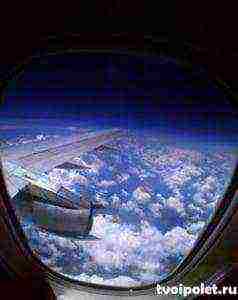Content
- 1 Shallots: the difference from onions
- 2 How to grow shallots with seeds
- 3 When and how to plant shallots in the ground
- 4 How to care for shallots
- 5 Growing and caring for shallots on video:
- 6 Harvesting and storage
- 7 Types and varieties of onions that give dense greens
- 8 When is the best time to plant onions outdoors
- 9 How to plant sevok correctly
- 10 Care rules
- 11 When to harvest green onions
Shallots or Ascalonian onions are a type of onion. Originally from the Middle East. Introduced to European countries in the 13th century. In those days it was called Eshkalot (after the biblical name of the city where it was grown), then the name passed into shallot. It is also called kvochka, kushchevka, since one plant forms a nest of bulbs (5-30 bulbs each). It reproduces successfully in a vegetative way: one planted onion produces about 40 new ones. Seed propagation is rarely used.
Shallots: the difference from onions
Shallots are grown for green feathers, although the bulbs are also edible. Early maturity is a distinctive feature of this type of onion. You can get a crop in greenhouses as early as February, and when grown outdoors, green feathers are ready for cutting a month after planting. Bulbs are well stored in winter - they do not dry out, do not germinate.
Shallots can be called gourmet onions: the leaves do not coarsen for a long time, the bulbs have a delicate semi-sweet taste, the culture does not cause tearing during processing, and there is no unpleasant aroma from the mouth after being eaten fresh.
It is shallots that are the main ingredient of the famous onion soup - after cooking, a unique taste remains, it does not drown out other products. Shallots are eaten fresh (appetizer, side dish, in salads), pickled, fried.
The plant is rich in minerals, sugars, ascorbic acid, and has medicinal properties.
How to grow shallots with seeds
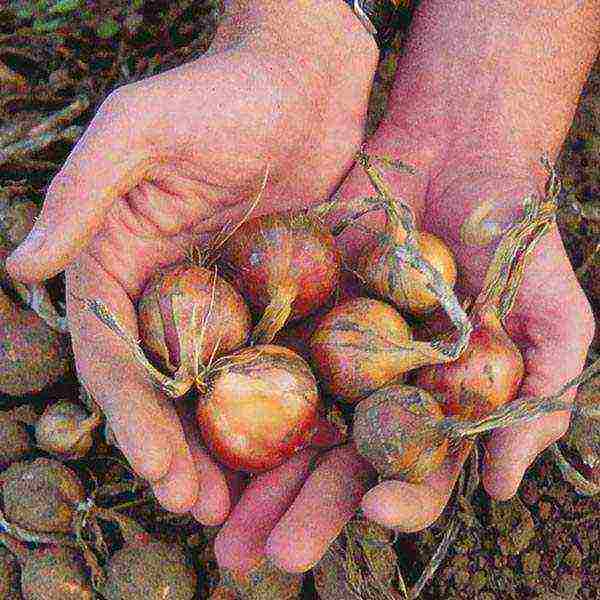
How to grow shallots from seeds photo set
Shallots, like onions, are a biennial culture. Initially, it is necessary to sow the culture with nigella seeds in order to get small bulbs - onion sets.
Chernushka onions are sown in moist, ripe soil in early spring (March-April) or late autumn before winter, at the end of October (so that Chernushka does not rise until spring).
And to make the onion set large, you need to sow it less often and water it well.
Prepare the bed in advance, carefully digging up and loosening the ground. Let the earth settle and start sowing:
- The furrows are made shallow so that the sowing is no deeper than 1-2 cm.
- The distance between the rows is 15-20 cm.
- The distance between the seeds is as small as possible, so that later it is easier to break through.
- After sowing, the furrows are carefully closed with the back of the rake, or better, they are manually covered with light loose soil in half with humus.
After sowing, the garden bed must be watered so that there is no stagnation of water, otherwise an earthen crust will form, which is detrimental to delicate seedlings. It is advisable to water every day, only slightly moistening the garden. With this care, the black onion will quickly "pop out" out.
For sevka
When shoots appear, they are thinned 2-3 times, leaving 4-5 cm between the plants. This distance is enough to grow a full-fledged onion set.
To get greenery on a feather
Break through seedlings only at a distance of 3-4 cm, this is enough to obtain beautiful juicy greenery. Water it abundantly at least once every 5 days.
Shallot Seeding Care
Further care consists in regular watering and loosening of the soil. Twice a season, you can feed with fermented grass or any other nitrogen fertilizing.
When the feather of the onion begins to turn yellow, watering is stopped, allowing the bulbs to ripen. After the tops have lodged, the onion sets are picked out of the ground, dried in a shady place, put in boxes and stored in a cool, dry room.
When and how to plant shallots in the ground
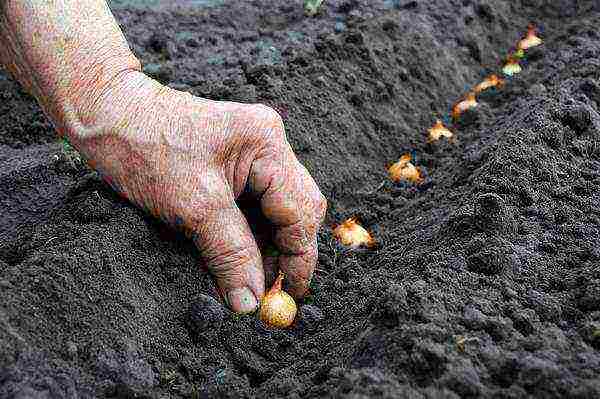
How to plant shallots photo
You can plant shallots in the spring (in April) or before winter (mid-October)... In the middle lane, it is better to plant in spring. When planting in autumn, it is important that the plant takes root, but does not begin to actively grow.
- The depth of planting the bulbs in the spring is about 6 cm, in the fall - 10 cm.
- The root collar should be covered with a 2-3 cm layer of soil.
- Maintain a distance of about 10 cm between individual bulbs and 20 cm between rows.
- When planting before winter, be sure to mulch with humus.
- Large bulbs give a large number of babies, but to get the green part, it is better to plant small and medium bulbs.
The soil is needed loose, fertile. For digging for each m², add 4-6 kg of humus.
Photophilous culture: Plant in open areas with bright sunlight.
How to care for shallots
Watering
Keep the soil slightly moist at all times, but avoid stagnant water. Water 3-4 times a week between May and mid-July. Reduce watering from the second half of summer, and stop altogether 2-3 weeks before harvesting.
Loosen the soil regularly, deepening 5-6 cm between rows, being careful not to touch the plant roots.
To make the bulbs large
You can thin out the nests to get larger bulbs. Gently rake off the ground, pull out small bulbs together with feathers, leaving large specimens.
Top dressing
Feed twice during the growing season. Apply the first top dressing 2 weeks after the feathers grow on the bulbs, the second at the beginning of the formation of the bulbs. As a top dressing, you can use organic matter (solution of chicken manure or mullein) or mineral fertilizers (the first top dressing is 10 g of ammonium nitrate, 10-15 g of superphosphate, the second top dressing is 10-15 g of superphosphate and potassium chloride per 1 m²).
Growing and caring for shallots on video:
Harvesting and storage
- Start harvesting the bulbs when about 50-70% of the feathers wilted.
- Dig up the bulbs along with the feathers; they must absolutely not be left in direct sunlight.
- In this form, dry for 10-12 days under a canopy, ensuring dryness and ventilation.
- Then cut off all the feathers, leaving only the thin, dried neck of the plant.
- It is better not to divide the nests into separate bulbs.
- Place the dried shallots in crates or boxes and store between 0 ° C and +3 ° C.
Plucking a bunch of green onions in early spring is a delight. For the owner of a country house or summer cottage, it is easy to get a feather for greenery. A polycarbonate greenhouse will speed up the process.
Types and varieties of onions that give dense greens
Multi-primordial varieties give dense greens. Consider the most productive varieties - a multi-primordial variety that gives a large amount of feathers per season and popular varieties of shallots:
Chipoluccio
Chipoluccio is an early ripening, fruitful shallot variety. The greens after planting can be cut off after 2-3 weeks. The pen has original pungent taste... Bulb weight up to 50 g. The growing season is 70 days.
Aristocratic
Aristocratic - shallots. From one sowing bulb in the nest, from 6 to 12 pieces of new ones are formed, weighing from 50 to 100 g. People call this species a family one.
The variety is early ripening, full-fledged bulbs ripen in 70 days. Cut greens are ready in 4 weeks.
The Aristocratic variety is used to produce greens on an industrial scale.
 From one onion of the Aristocratic variety, 6-12 new ones are formed
From one onion of the Aristocratic variety, 6-12 new ones are formed
Old Russian
Old Russian (red, yellow) - a variety of shallots.Produces a powerful, bright green feather with a waxy coating. Seed material is stored well and for a long time (2 years). The variety is resistant to many diseases of bulbous crops. Up to 10 pieces are formed in the nest.
Reproduction is only vegetative, since the arrows are not formed. Gardeners consider this species most cost-effective for forcing greens... Cut shallots are ready 20-30 days after planting.
Lilac ringing
Chive bow Lilac ringing is 7 kg of greens per season from 1 sq.m. soil. The variety is early ripe, when grown in open ground, the cut is carried out after 20 days. Several cuts are carried out over the summer. The variety is frost-resistant.
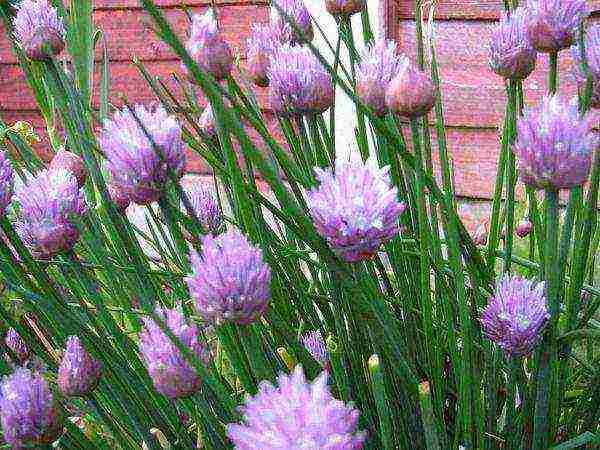 Chive Bow Lilac Chime
Chive Bow Lilac Chime
Studgarten Riesen
Stuttgarten Riesen is a multi-primordial, high-yield variety with good immunity to most diseases. The productivity of the variety is high.
If there are 4-6 primordia in the seed from 1 sq. m get up to 15 kg of greens.
When is the best time to plant onions outdoors
For home consumption, a turnip for greenery can be planted in open ground at the end of April, provided that the earth has warmed up and its temperature at night and morning hours is not lower than 12 degrees.
For commercial purposes, turnip greens are grown in a greenhouse. If there is heating there, forcing can be done throughout the year.
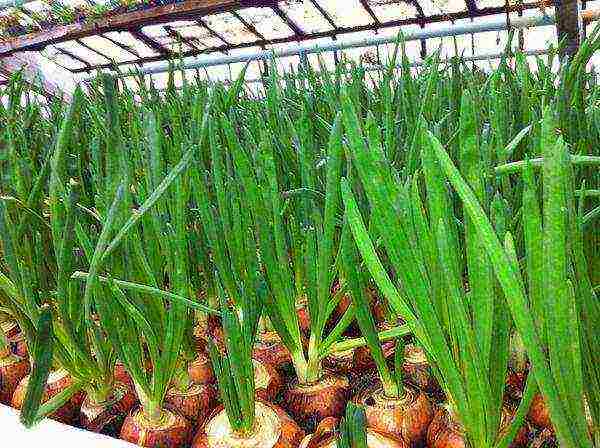 On an industrial scale, green onions are grown in greenhouses.
On an industrial scale, green onions are grown in greenhouses.
The main thing you need to get a pen:
- high-quality seed;
- fertile substrate;
- watering;
- top dressing;
- backlight.
A full harvest of green feathers is obtained with 12 hour daylight hours. For cultivation in greenhouses, select varieties with a short dormant period.
With a long daylight hours, the optimum air temperature 18-22 degrees... The yield drops at lower temperatures. Higher air temperatures reduce product quality.
How to plant sevok correctly
There are proven methods for planting turnip greens. Experienced gardeners successfully apply planting methods:
- pavement;
- tape.
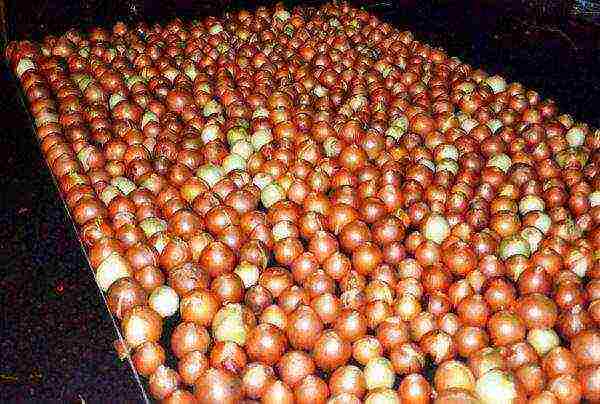 Bridge way of landing
Bridge way of landing
In addition to the landing method, it is important choose the right place and prepare fertile soil (substrate) before sowing any variety.
Choosing a place for growing
When choosing a place for planting sevka on greens, take into account the principles of crop rotation.
Plant after crops:
- cucumbers;
- zucchini;
- pumpkins;
- cabbage;
- a tomato;
- potatoes.
In the shade, the onion grows poorly, the feather is pale and thin. It is better to arrange ridges in an open, sunny position... During rains, there should be no stagnation of moisture on it.
Competent soil preparation for planting
We prepare a bed for planting in the fall before planting. Determine the acidity of the soil. With increased acidity, add dolomite flour... Consumption - 50 g-per sq. m. Onions love loose soils with a pH of 6.5 to 7.5.
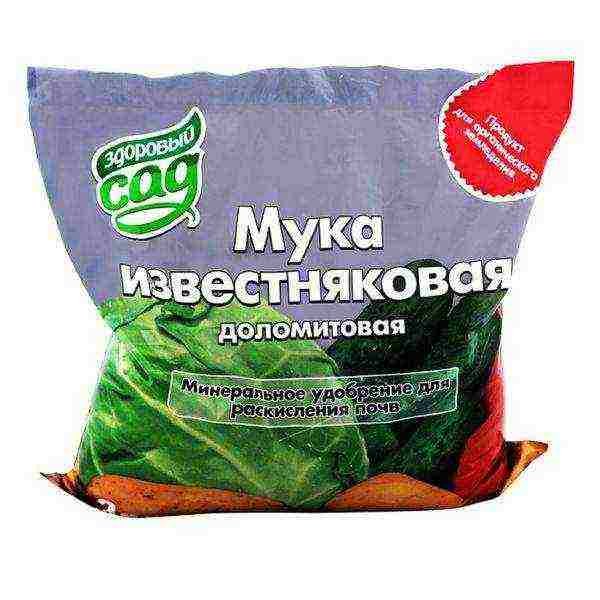 With increased acidity of the soil, add dolomite flour
With increased acidity of the soil, add dolomite flour
In the fall, under the digging, add:
- Humus ½ bucket;
- Superphosphate 2 tbsp. l;
- Potassium chloride 1 tbsp. l.
Consumption is indicated per sq. m. Dig up the soil 20 cm with a shovel or walk-behind tractor. In the spring, dig it up again and make urea 10 g-sq. m. 7 days before sowing, water the ridge with solution copper sulfate... Pour 10 liters of water into a watering can and dissolve 20 g of the drug in it.
Planting onions for forcing on a feather
Good greenery growth will provide quality seed.
Bulbs should be stored in a warm room until planting. Before planting seed sevka in the garden, they need to be sorted out. Discard damaged copies. Sort by size. Bulbs give the greatest yield of feathers from 2 to 4 cm diameter, weighing from 15 to 40 g.
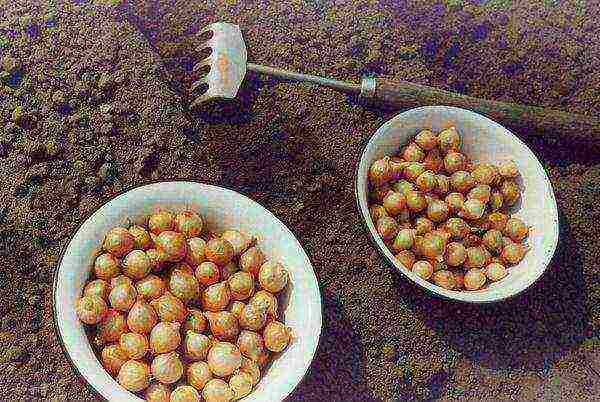 For growing onions on a feather, it is best to choose bulbs 2-4 cm in diameter.
For growing onions on a feather, it is best to choose bulbs 2-4 cm in diameter.
Experienced gardeners recommend before planting to carry out activities that increase yields, accelerate germination:
- The selected material must be moistened and, within 48 hours, kept in a warm room at an air temperature of 25 degrees.
- Quarter length trim off the tops near the bulbs.
- Dissolve 30 g of ammonium nitrate in 10 liters of warm water (35 degrees), lower the bulbs in it for 16 hours.
Approximate sevka consumption for the bridge method 13 kg per sq.m... The consumption is high, because the bulbs are stuck into the ground tightly to each other. The aisles are not made. The advantages of this method are obvious:
- the landing area is saved;
- all the forces of the plant go to the formation of the feather.
The bridge method is especially useful for growing onions in greenhouses.
The tape method involves formation of furrows at intervals of 10 cm... The bulbs are placed in the grooves tightly to each other or with a small 1-2 cm indent. Furrows are covered with a thin layer of earth (2 cm).
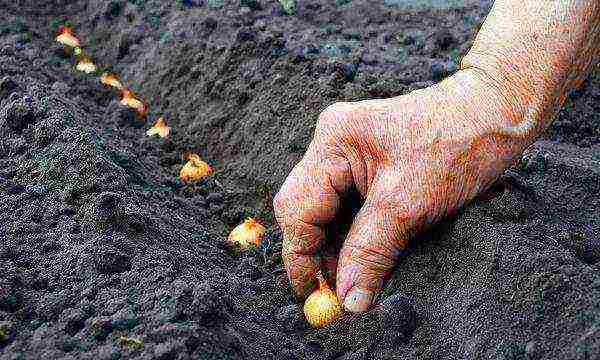 Tape method of planting onions
Tape method of planting onions
Care rules
The main care of the crop outdoors is in the right watering... In its absence, the feather is bitter and thin. With an excess of the bulbs rot, the harvest suffers.
To maintain the required humidity, take into account the weather and check the soil moisture at a depth of 3 cm. It is roughly recommended to water 2 times a week in the absence of rain.
Water only in the evening. This will eliminate unnecessary heating of the soil. Onions do not like high temperatures.
If the soil is prepared correctly and filled with organic matter and mineral fertilizers, top dressing can be skipped. With the belt planting method, loosen the ground between the rows, remove weeds.
When to harvest green onions
Crop is harvested based on the length of the feather. The entire ridge will have seedlings of the same length, if the seeds were calibrated in size before planting and the seedlings of the same variety were planted.
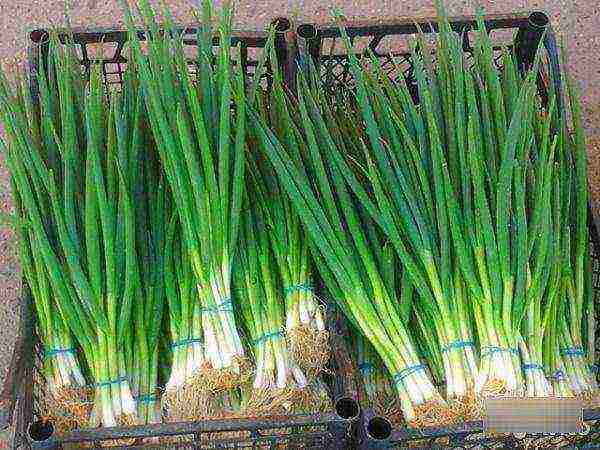 The marketable size of onion feathers is 24-42 cm
The marketable size of onion feathers is 24-42 cm
For all grades, the requirements for the length of the feather are the same. The size is considered commodity from 24 to 42 cm... When this length is reached, the feathers are cut for sale or for personal consumption.
You don't need to spend a lot of time and effort to get a feather for greens for home consumption. Before forcing turnips for greens on a large scale, it is worth assessing your capabilities on a small volume. Choose the most productive variety, master the technology for the preparation of planting material and soil. With the right approach, success is guaranteed.
Green onions are not only a source of vitamins and nutrients, but also a decoration for a wide variety of dishes. Therefore, it is popular with chefs at all seasons. Housewives try to grow onions on a feather on the windowsills in the cold season so that the family is guaranteed to be provided with vitamins, but you must admit that you can also grow onions on a feather in a greenhouse! By the way, this does not require any extra effort, everything is extremely simple, it is enough to perform elementary agrotechnical techniques.
Start growing greens by preparing greenhouses and soil in the garden. The greenhouse needs to be cleaned, to check the performance of its heating system - this is especially important if you decide to plant onions for the winter. Check the lighting - for sure there will be a need for additional lighting. By the way, it is better to install the lamps vertically, then you get a straight and beautiful green feather.
Almost all agricultural crops require a well-fertilized soil that contains a complex of essential mineral and organic substances. A feather-bow is one of them, in addition, he also loves breathable, not heavy earth. Therefore, prepare in advance a mixture of soil for the beds, you should add there:
- manure or compost - about one bucket per square meter;
- superphosphate - 30 grams per square meter;
- potassium chloride - 15 grams per square meter.
In order for the cultivation of onions, especially in winter, to be less costly, it is necessary to carefully select varieties of green onions and study their features of agricultural technology and development. They are planted in early spring or autumn (for a winter harvest). By the way, onions are not suitable for this, since in the off-season they are at rest, when the bulb develops rather slowly. And no matter what you do, you will not get a high yield.
The most suitable onion varieties
For growing high-quality greens, perennial onions are best suited, namely:
- Leek
Leek, also called pearl. It does not have a bulb, but it has a thick, whitish stem, which is the most delicious part. The broad leaves also have a pleasant and delicate taste. The feathers are a bit like garlic. The yield is about 20 kilograms per hundred square meters.
Onion-batun, it is also called sandy, Tatar and fisty, also does not have a bulb, but if we compare it with other species, then it is distinguished by a higher content of vitamins and microelements by more than two times.
For perennial varieties of onions on a feather, it is possible to cut up to three times during the growing season, and for annual varieties only once. The yield per one hundred square meters can reach from 20 to 30 kilograms.
- Shallot
Shallots are somewhat superior to onions in terms of their taste and mass of green feathers. The advantages of this variety can also be attributed - unpretentiousness during cultivation, and yield, which can reach 40 kilograms from one hundred square meters.
Chives, also called chives, have narrow feathers that can reach a length of up to 50 centimeters. They are fragrant and can be delicate for a long time. Productivity - about 20 kilograms per one hundred square meters.
- Slime onion
Slime onion. It is considered by many to be the most delicious type of onion. Differs in a faint aftertaste and smell of garlic, has delicate wide leaves. Compared to other types of slime onions, it contains more iron and vitamin C. It can grow all year round in a greenhouse, and in the open field - before the onset of cold weather. That is, the variety is very frost-resistant, and also early ripening with high yields.
- Tiered bow
A multi-tiered onion, it can also be called Egyptian or Canadian, has the highest frost resistance, withstands severe winters, and does not need special care.
Among the most popular varieties that provide a high yield and allow you to get high-quality onions for feathers are: Arzamassky, Bessonovsky, Spassky, Troitsky, Black Prince and Amber.
Onions on a feather in the open field
For different varieties of onions, the cultivation method is almost the same. For planting, select multi-pronged onions with a diameter of no more than 4 centimeters. They plant it in open ground either in the fall, before the onset of the first frosts, or in early spring, after the snow has completely melted.
Before planting, it is recommended to soak the bulbs for 24 hours in warm water - just above room temperature. Then cut off the top with a secateurs. This operation is performed so that oxygen penetrates into the bulb, and the onion begins to grow for forcing the feathers. By doing these simple manipulations, you will speed up the process and increase yields by 50 - 70 percent. It is also recommended to peel the bulbs from excess husk and sort by size. This is due to the fact that the timing of feather grazing differs in bulbs with different sizes. That is, to get a bountiful harvest, try to pick up planting material of the same size.
Onions are planted in several ways:
Tape method. Divide the bed into rows with a distance of 15 to 20 centimeters, and plant the bulbs in them every 3 to 4 centimeters. Then level the garden bed. For the winter, cover with a layer of manure or humus about 6 centimeters thick (you need to remove it in the spring).
Bridge method. Lay the bulbs tightly to each other, while lowering the roots down, cover them with earth on top - the layer thickness is about 3 centimeters. When planting before winter, cover as in the previous method. In the spring, remove this insulating layer and install an arc with a film over the bed.
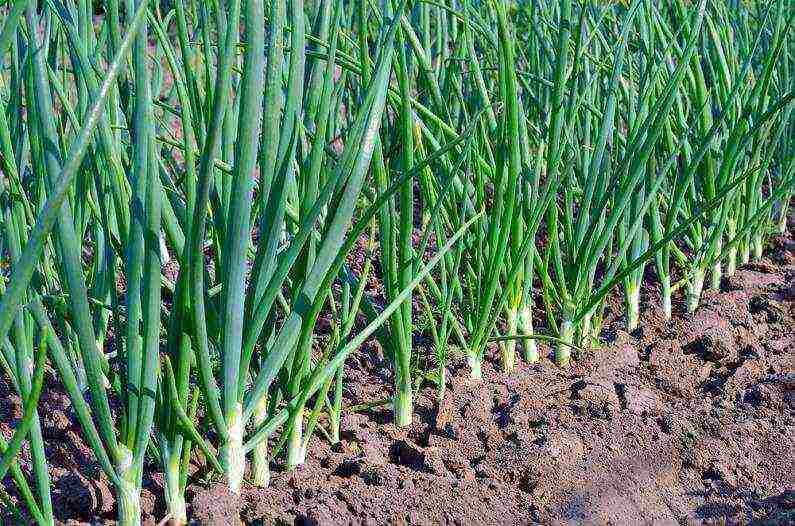
Growing outdoors from seeds
Feather onions can be grown not only from bulbs, but also from seeds. This method, although longer in time, is quite cheap. Especially if you take seeds of perennial varieties. Buy seeds no older than two years, and optimally take young ones.Be sure to check them for germination - an acceptable indicator: above 80 percent. Take 20 seeds and spread them out on a wet cloth. Count the number of hatching - if less than 16 pieces, then the quality of the planting material is unsatisfactory.
When you decide on germination, process the seeds. First, soak them in warm water for a day (during this time it is changed three times). Then drain the water, place the seeds for half an hour in a weak solution of potassium permanganate. The next procedure is to dilute a couple of drops of Epin-Extra in a glass of water and fill the seeds with this solution for 15-18 hours. Such complex processing will not allow the development of fungal diseases and will guarantee a good harvest.
If you plan on getting fresh, fragrant greens in the spring, then sow onion seeds in the middle of summer. An important condition - loosen the soil for planting well, and apply fertilizers. To do this, mix the soil with humus, plus add the following mixture: urea (15 grams), superphosphate (30 grams), potassium chloride (15 grams) and wood ash (200 grams).
Level the loosened bed and tamp it a little. Then make several rows 30 centimeters apart and plant the seeds. As soon as they germinate and give one matured leaf at a time, thin out the seedlings, leaving about 5 centimeters between them. At the end of autumn, the feather should grow up to 20 centimeters. For the winter, be sure to mulch the beds with straw or peat.
Growing seedlings from seeds
Seedlings can also be grown from seeds. Onions grown through seedlings yield good yields and grow much faster. Seeds for seedlings need to be planted two months before planting on beds in the open field. Soak the seeds in warm water for a day, then drain the water, and spread the seeds on a damp cloth. In this state, hold them for two days, constantly moisturizing the fabric as it dries.
Next, prepare the soil containers. The composition that you used for the open field version is suitable. Pour soil into the containers, make shallow grooves (about 1 centimeter), and plant the seeds 0.5 centimeters apart. Moisten the ground with a sprayer, cover with plastic wrap, and transfer containers to a warm, shaded area.
When the first feathers break through (3 - 4 shoots each), you can transplant into open ground. Onions have good frost resistance. If you grow seedlings at the beginning of spring, then in the month of April it can be moved to the beds, since the spring frosts that occur during this period of the year are not afraid of it.
In the cold period (late October - early April), onions on a feather are best grown in greenhouses. For planting, one-year and two-year-old onions are suitable. Only the bridge method is suitable for planting.
Soak the bulbs in warm water for 24 hours, and then put them one to one in the soil. If you pre-cut the tops, then you do not need to sprinkle them with anything. A good harvest is obtained if the bulbs are planted in special containers one-third filled with peat, compost or humus. After the end of planting, they are covered with a thin layer of soil. Two weeks after planting the onions, the temperature in the greenhouse is maintained around +20 ° C, but not higher.
It is also recommended to water the onion at least five times during the growing season. Collecting can begin when the feather grows to 30 - 40 centimeters.

Green onions give dishes an appetizing, spring-like bright look, at the same time saturating food with vitamins and useful elements. It is generally known that onion there is much more vitamin C than onion, however, the cost of fresh herbs in the store is higher. Therefore, in order to provide yourself with reliable protection from colds in the fall and winter, it is best to grow onions yourself for herbs in a greenhouse or on your own windowsill.
Types and varieties of onions that give dense greens
Planting portions of onions one after another using a conveyor belt method, you will always have the opportunity to cut a fresh feather to the table at any time of the year to decorate dishes and recharge with the necessary vitamins. Plus, feather onion farming can be a small but profitable family business that brings you steady profits throughout the year.
Almost every housewife knows how to grow onions for a feather at home. To get a green feather, you can plant the bulbs in a container that is one-third filled with soil, or simply place the bulbs vertically in a tray, adding water from time to time to cover the roots. But if you are interested in planting large quantities of onions on greens, it will be more convenient to create suitable conditions in a greenhouse or greenhouse (from October to May), or outdoors in a vegetable garden (from April to September).
When choosing onion varieties for a feather on a vegetable base, do not be too lazy to cut the onion across (if possible) to see how many rudiments have formed in it. If there is only one bud on the bulb, the amount of greenery will be small. Therefore, gardeners most often choose multi-primordial onion varieties for greens: Amber, Arzamassky, Bessonovsky, Black Prince, Rostovsky.
Video about forcing onions on a feather
Such types and varieties of onions for greens are also popular, such as:
- Onion (other names are Tatar, sandy, fist, winter). Gives even greens, the cost of planting material is lower than that of turnip onions. In perennial varieties of batun, a green feather can be cut 2-3 times during the growing season, in annuals - 1 time. Feather yield reaches 20-35 kg from 9 sq.m.
- Chives (chisel). It is valued for its narrow, long (up to 50 cm), fragrant leaves that remain tender for a long time and do not coarse. Productivity - up to 30 kg from 9 sq.m.
- Leek (pearl). Feathers are similar in appearance to garlic, broad-linear leaves have a delicate taste. The yield is about 20 kg from 9 sq. M.
- Shallot... In terms of the quality and quantity of green feathers, it surpasses onion-turnip. It is unpretentious, gives a good harvest - from 25 to 45 kg from 9 sq.m.
- Slime onion... The broad, flat leaves have a delicate texture and a faint garlic aroma. The variety is early ripening, frost-resistant, fruitful. Indoors it grows all year round, and in the beds it stops growing only with the onset of frost.
- Tiered bow (Egyptian, Canadian). The most unpretentious and frost-resistant type of onion, surpasses the batun in productivity and quality of greens. Does not freeze even on cold winter days.

For green feathers, you can plant the bulbs in a container.
Growing onions for greens in the open field
Different types of onions are grown in about the same way, usually a multi-pronged onion with a diameter of 2.5-4 cm is used as planting material.It is planted in open ground in the fall, two weeks before frost, or in early spring, the snow will melt a little. Before planting, the bulbs are soaked in warm water for a day, and the top is cut off from them. Thanks to such preliminary measures, the forcing of onions for greens is faster, and the yield increases by 55-75%.

Before planting, the bulbs are soaked in warm water for a day, and the top is cut off from them.
Onion greens are grown bridge way: the bulb is placed close to the bulb, with the roots down (about 11-13 kg of onions are taken per 1 sq. m.), or tape (in the grooves, the bulbs are at a distance of 1-4 cm, between rows 10-20 cm). With the belt method, the bed is leveled, and with the pavement method, a 2-3 cm layer of soil is poured onto the bulbs on top.For winter planting, it is recommended to pour humus or manure on top with a layer of 3.5-5 cm, and in spring, remove and install a film frame over the bed.
Video about forcing onions for greens
You can also grow onions from seeds.This method takes more time, but costs less, especially if you choose perennial onions, since such onion seeds for greens are much cheaper than turnip onions.
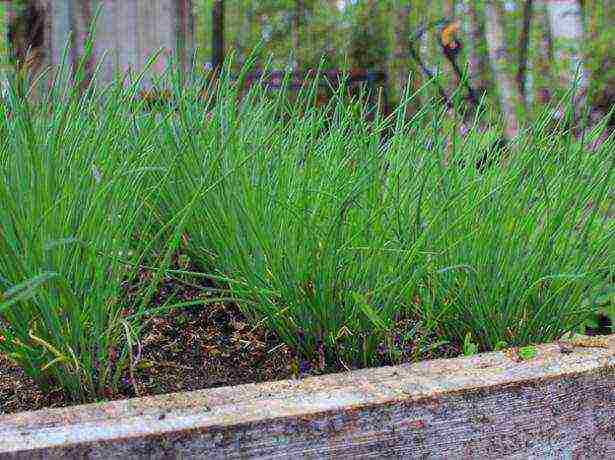
You can also grow onions on a feather from seeds.
In order to get fresh greens by spring, onion seeds on a feather should be sown in open ground in mid-July. At the same time, the soil must be prepared carefully, loosened up and enriched with organic fertilizers. Before sowing, the bed is leveled, slightly compacted and the seeds are sown in continuous rows, with row spacing of 32-42 cm.When one true leaf appears at the seedlings, the crops are thinned out, so that in the end there are 3.5-5 cm between the plants.For the winter, the bed with onions, the feathers of which will rise to 20-30 cm, mulch with straw or peat. And in the spring, as the snow melts, you will have fresh greens.
Greenery all year round from a greenhouse or greenhouse
From October to April, it is convenient to grow onions for greens in a greenhouse, and from February to May, in a greenhouse. Planting is carried out only by a bridge method from a one-year or two-year-old selection onion. Place the bulbs previously soaked in warm water firmly on the soil. From above, you can cover them with a layer of peat or humus, or you can not cover them. If the tops of the bulbs are cut off, you do not need to cover them with soil in the greenhouse.

From October to April, it is convenient to grow onions for greens in a greenhouse, and from February to May - in a greenhouse.
A good harvest is obtained when onions are planted on a feather in boxes filled with compost, humus or peat. After planting the bulbs in boxes, they are sprinkled with soil on top and the boxes are stacked for 10-15 days, which allows you to use the vacated space in the greenhouse with maximum benefit (for planting the next batch of onions). After two weeks after planting, the boxes are distributed around the greenhouse and make sure that the air temperature in it does not exceed +19 degrees. During the entire growing season, green onions need to be watered at least four times, and between waterings, fertilize with mineral fertilizers. You cannot use any chemicals when forcing onions on greens. Collect the feather when it reaches a height of 24-42 cm.

